第八讲 拟声词的翻译
- 格式:ppt
- 大小:357.50 KB
- 文档页数:23
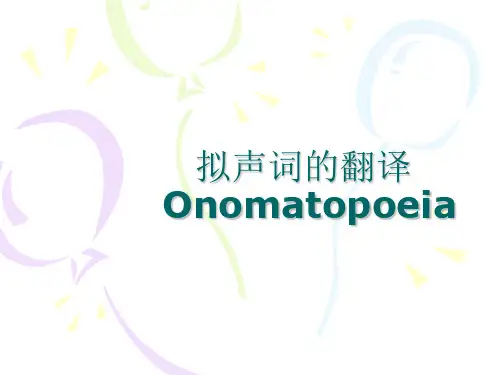
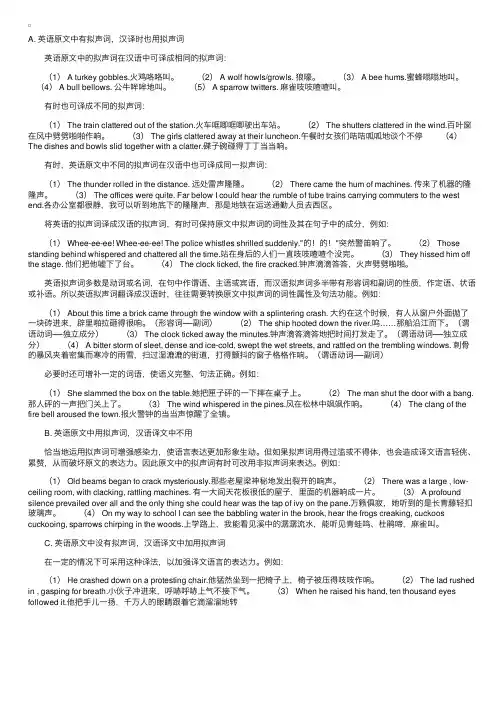
A. 英语原⽂中有拟声词,汉译时也⽤拟声词 英语原⽂中的拟声词在汉语中可译成相同的拟声词: (1) A turkey gobbles.⽕鸡咯咯叫。
(2) A wolf howls/growls. 狼嚎。
(3) A bee hums.蜜蜂嗡嗡地叫。
(4) A bull bellows. 公⽜哞哞地叫。
(5) A sparrow twitters. ⿇雀吱吱喳喳叫。
有时也可译成不同的拟声词: (1) The train clattered out of the station.⽕车哐唧哐唧驶出车站。
(2) The shutters clattered in the wind.百叶窗在风中劈劈啪啪作响。
(3) The girls clattered away at their luncheon.午餐时⼥孩们咭咭呱呱地谈个不停 (4)The dishes and bowls slid together with a clatter.碟⼦碗碰得丁丁当当响。
有时,英语原⽂中不同的拟声词在汉语中也可译成同⼀拟声词: (1) The thunder rolled in the distance. 远处雷声隆隆。
(2) There came the hum of machines. 传来了机器的隆隆声。
(3) The offices were quite. Far below I could hear the rumble of tube trains carrying commuters to the west end.各办公室都很静,我可以听到地底下的隆隆声,那是地铁在运送通勤⼈员去西区。
将英语的拟声词译成汉语的拟声词,有时可保持原⽂中拟声词的词性及其在句⼦中的成分,例如: (1) Whee-ee-ee! Whee-ee-ee! The police whistles shrilled suddenly."的!的!"突然警笛响了。
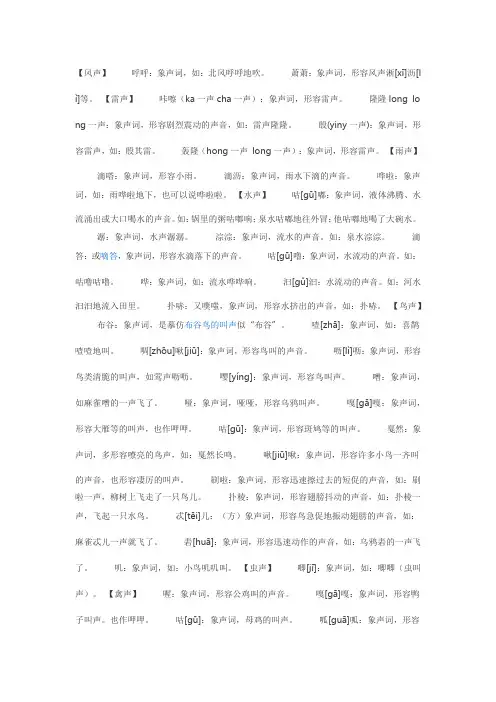
【风声】呼呼:象声词,如:北风呼呼地吹。
萧萧:象声词,形容风声淅[xī]沥[l ì]等。
【雷声】咔嚓(ka一声cha一声):象声词,形容雷声。
隆隆long long 一声:象声词,形容剧烈震动的声音,如:雷声隆隆。
殷(yiny一声):象声词,形容雷声,如:殷其雷。
轰隆(hong一声long一声):象声词,形容雷声。
【雨声】滴嗒:象声词,形容小雨。
滴沥:象声词,雨水下滴的声音。
哗啦:象声词,如:雨哗啦地下,也可以说哗啦啦。
【水声】咕[gū]嘟:象声词,液体沸腾、水流涌出或大口喝水的声音。
如:锅里的粥咕嘟响;泉水咕嘟地往外冒;他咕嘟地喝了大碗水。
潺:象声词,水声潺潺。
淙淙:象声词,流水的声音。
如:泉水淙淙。
滴答:或嘀答,象声词,形容水滴落下的声音。
咕[gū]噜:象声词,水流动的声音。
如:咕噜咕噜。
哗:象声词,如:流水哗哗响。
汩[gǔ]汩:水流动的声音。
如:河水汩汩地流入田里。
扑哧:又噗嗤,象声词,形容水挤出的声音,如:扑哧。
【鸟声】布谷:象声词,是摹仿布谷鸟的叫声似“布谷”。
喳[zhā]:象声词,如:喜鹊喳喳地叫。
啁[zhōu]啾[jiū]:象声词,形容鸟叫的声音。
呖[lì]呖:象声词,形容鸟类清脆的叫声,如莺声呖呖。
嘤[yíng]:象声词,形容鸟叫声。
噌:象声词,如麻雀噌的一声飞了。
哑:象声词,哑哑,形容乌鸦叫声。
嘎[gā]嘎:象声词,形容大雁等的叫声,也作呷呷。
咕[gū]:象声词,形容斑鸠等的叫声。
戛然:象声词,多形容嘹亮的鸟声,如:戛然长鸣。
啾[jiū]啾:象声词,形容许多小鸟一齐叫的声音,也形容凄厉的叫声。
刷啦:象声词,形容迅速擦过去的短促的声音,如:刷啦一声,柳树上飞走了一只鸟儿。
扑棱:象声词,形容翅膀抖动的声音,如:扑棱一声,飞起一只水鸟。
忒[tēi]儿:(方)象声词,形容鸟急促地振动翅膀的声音,如:麻雀忒儿一声就飞了。
砉[huā]:象声词,形容迅速动作的声音,如:乌鸦砉的一声飞了。

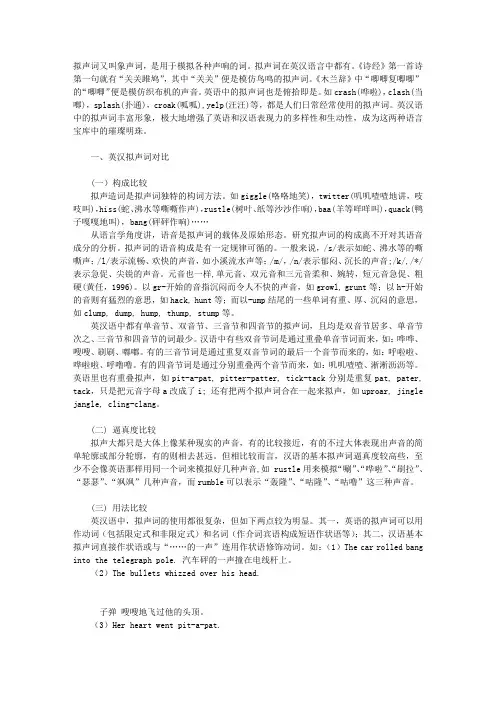
拟声词又叫象声词,是用于模拟各种声响的词。
拟声词在英汉语言中都有。
《诗经》第一首诗第一句就有“关关雎鸠”,其中“关关”便是模仿鸟鸣的拟声词。
《木兰辞》中“唧唧复唧唧”的“唧唧”便是模仿织布机的声音。
英语中的拟声词也是俯拾即是。
如crash(哗啦),clash(当啷),splash(扑通),croak(呱呱),yelp(汪汪)等,都是人们日常经常使用的拟声词。
英汉语中的拟声词丰富形象,极大地增强了英语和汉语表现力的多样性和生动性,成为这两种语言宝库中的璀璨明珠。
一、英汉拟声词对比(一)构成比较拟声造词是拟声词独特的构词方法。
如giggle(咯咯地笑),twitter(叽叽喳喳地讲,吱吱叫),hiss(蛇、沸水等嘶嘶作声),rustle(树叶、纸等沙沙作响),baa(羊等咩咩叫),quack(鸭子嘎嘎地叫),bang(砰砰作响)……从语言学角度讲,语音是拟声词的载体及原始形态。
研究拟声词的构成离不开对其语音成分的分析。
拟声词的语音构成是有一定规律可循的。
一般来说,/s/表示如蛇、沸水等的嘶嘶声;/l/表示流畅、欢快的声音,如小溪流水声等;/m/,/n/表示郁闷、沉长的声音;/k/,/*/表示急促、尖锐的声音。
元音也一样,单元音、双元音和三元音柔和、婉转,短元音急促、粗硬(黄任,1996)。
以gr-开始的音指沉闷而令人不快的声音,如growl, grunt等;以h-开始的音则有猛烈的意思,如hack, hunt等;而以-ump结尾的一些单词有重、厚、沉闷的意思,如clump, dump, hump, thump, stump等。
英汉语中都有单音节、双音节、三音节和四音节的拟声词,且均是双音节居多、单音节次之、三音节和四音节的词最少。
汉语中有些双音节词是通过重叠单音节词而来,如:哗哗、嗖嗖、刷刷、嘟嘟。
有的三音节词是通过重复双音节词的最后一个音节而来的,如:呼啦啦、哗啦啦、呼噜噜。
有的四音节词是通过分别重叠两个音节而来,如:叽叽喳喳、淅淅沥沥等。

中英拟声词介绍A cat miaows /mews/purrs.猫"喵喵"叫。
狗bark. bark除了有"犬吠"的意思外,还有"树皮"的意思。
另外还有yap(汪汪叫)想一下不停的狗吠是不是很招人烦,所以yap这个词另外的意思就是"吵嚷"。
另外yelp 和snarl也是常用来形容狗叫的。
A dog yaps/ yelps/ barks/ snarls.狗吠。
quack这个词除了用来形容鸭子叫之外还可以用来指"江湖医生,庸医。
"记住了这个quack害人真是不浅呀。
A cock crows.公鸡啼。
这个crow的意义可非同一般,"公鸡啼鸣"它表示新的一天又开始了。
还记得红楼梦里薛蟠哼的那首打油诗吗?"一个苍蝇嗡啊嗡,一个蚊子哼啊哼。
"它们的声音听起来真是令人讨厌。
英语里又是用什么词来形容它们的声音呢?只要这两个词就可以了:buzz(嗡嗡)hum(哼哼) A fly hums/ buzzes/ drones.苍蝇"嗡嗡"叫。
A bee/ mosquito hums/ buzzes.蜂/蚊子"嗡嗡"叫。
这里hum除了尤指蜜蜂发"嗡嗡"(a continuous buzz)声,发"哼哼"声外,还可以用来指人等"闭嘴哼唱",如:hum a song 哼一首歌。
A chick cheeps/ pips/ pules/ peeps.小鸡"叽叽"叫。
A bird/ sparrow twitters /chirps/ chirrups.鸟/麻雀"唧唧喳喳"叫。
A rat squeaks.耗子"唧唧"叫。
A calf/lamb/goat bleats.小牛/小羊/山羊叫。
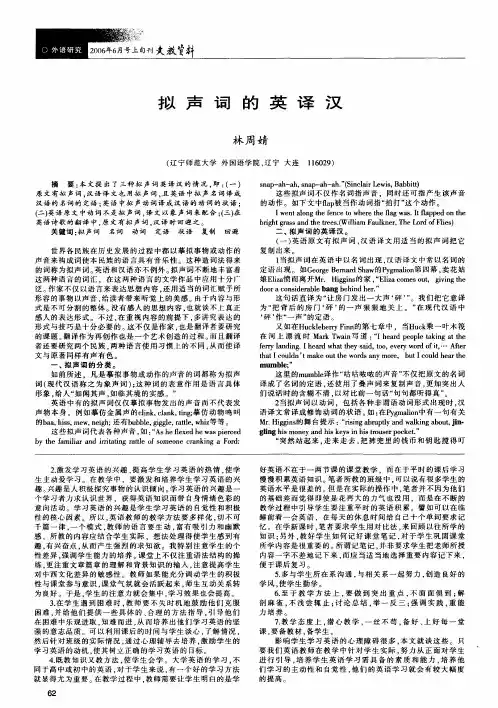
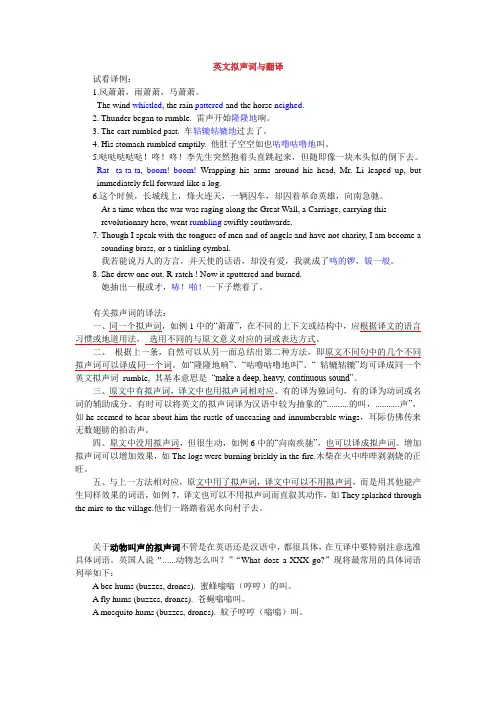
英文拟声词与翻译试看译例:1.风萧萧,雨萧萧,马萧萧。
The wind whistled, the rain pattered and the horse neighed.2. Thunder began to rumble. 雷声开始隆隆地响。
3. The cart rumbled past. 车轱辘轱辘地过去了。
4. His stomach rumbled emptily. 他肚子空空如也咕噜咕噜地叫。
5.哒哒哒哒哒!咚!咚!李先生突然抱着头直跳起来,但随即像一块木头似的倒下去。
Rat- ta-ta-ta, boom! boom!Wrapping his arms around his head, Mr. Li leaped up, but immediately fell forward like a log.6.这个时候,长城线上,烽火连天,一辆囚车,却囚着革命英雄,向南急驰。
At a time when the war was raging along the Great Wall, a Carriage, carrying thisrevolutionary hero, went rumbling swiftly southwards.7. Though I speak with the tongues of men and of angels and have not charity, I am become asounding brass, or a tinkling cymbal.我若能说万人的方言,并天使的话语,却没有爱,我就成了鸣的锣,钹一般。
8. She drew one out. R-ratch ! Now it sputtered and burned.她抽出一根或才,哧!啪!一下子燃着了。
有关拟声词的译法:一、同一个拟声词,如例1中的“萧萧”,在不同的上下文或结构中,应根据译文的语言习惯或地道用法,选用不同的与原文意义对应的词或表达方式。
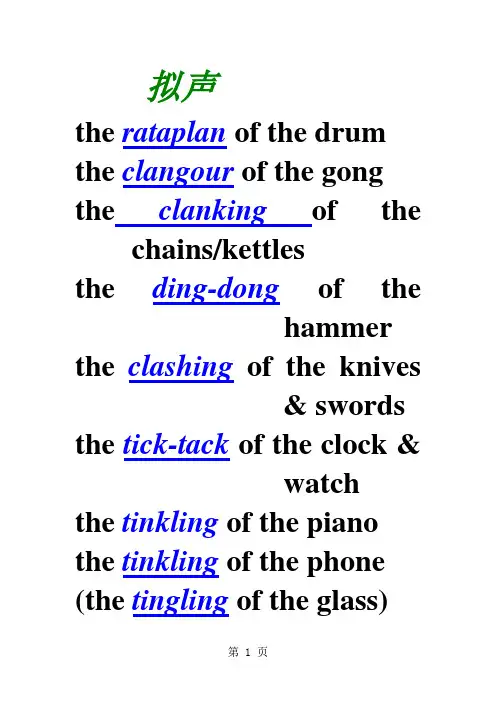
拟声the rataplan of the drum the clangour of the gong the clanking of the chains/kettlesthe ding-dong of thehammer the clashing of the knives& swords the tick-tack of the clock &watchthe tinkling of the piano the tinkling of the phone (the tingling of the glass)the jingling of the bellsthe jangling of the bicycle the screeching of thebrakes the squeaking of the radio the creaking/ rattling of thehandcart the rumbling of the cart the rumbling of the truck (the rumbling of thethunder) (the rumbling of thestomache) (the booming of artillery)the bumping of the vanthe clanging of the tram&trolley the humming of thesubway the puffing of the trainthe tooting of the bugle & horn & train whistle the shrieking of the siren (fire~/air-raid/ambulance) the whee-ee-ee of thepolice whistles the whirring of themachinethe clacking, rattling of themachines the clattering of theautomotons the clattering of bowls and dishes/knives and forks the clattering of the horse the clip-clop of the horse the chattering of a machine& a machine gun the banging of the door the slamming of the door the crashing of the door the crashing of the planethe crashing of thunderand lightning the thwacking(whacking)on the desk the banging of thefirecrackers the cracking of thefireworks the cracking of theburning sticks the r-ratching of thematchesthe sputtering of the sparks the rustling of the leaves水等液体声the rippling of the stream the chattering of the water the bubbling of the water( “splish-splosh” ) the sizzling of the liquida sizzling hot daythe drip-drop of the water the splashing of the rain splash through the mire squelch through the snow( “puchi-puchi” ) the squashing of the waterin the wet rainboots人发出的各种声音the clicking of thehigh-heeled shoes the plopping of theteardrops the thudding of the heart the thumping on the chest smack sb. In the face gurgle down the throat keep on clack-clack-clacking whispering and chattering muttering / mur-muring sneezing / snoringthe chattering / prattling ofthe children the whoops of joy( “hurrah”“hurray” ) ( shout/yell/shriek/whistle ) chuckle抿嘴暗笑/咯咯叫giggle咯咯傻笑snicker/snigger窃笑/马嘶鸣sniff嗤之以鼻snort“哼”sneer讥笑sputter唾液飞溅sobbing / crying of sadnessgrunt / grumble / mumbleof complaints “Ouch”in the pain各种动物叫声An ass brays. (hee-haws).A bee hums.(buzzes, drones).A bird twitters.(chirps, chirrups).A bittern booms.A bull bellows(lows).A calf bleasts.A cat miaows.(miaus, mews, purrs)A chick cheeps.(pips, peeps) A cicada chirps/chirrups.A cock crows.A cow moos(lows).A crane whoops.A cricket chirps/chirrups.A crow caws(croaks).A deer bleats.A dog barks.(yaps, yelps, bays,snarls, growls, howls) A donkey brays(hee-haws).A dove coos.A duck quacks.An elephant trumpets.A fly hums/buzzes/drones.A fox yelps.A frog croaks.A goat bleats.A goose cackles(gaggles).A hen cackles. (chucks, chuckles, clucks) A horse neighs.(whinnies, nickers) A lamb bleats(baas).A lion roars.A magpie chatters.A monkey screeches. (chatters, gibbers, jabbers) A mosquito hums/buzzes.A mouse squeaks(peeps).A nightingale jugs/jug-jugs An owl hoots(whoops).A parrot squawks.A pig grunts(squeals).A pigeon coos.A sheep bleats(bass).A snake hisses.A sparrow twitters(chirps) A tiger growls.A turkey gobbles.A whale blows.A wild-goose honks.A wolf howls(growls). Translation of Onomatopoeia英语拟声词多用做动词或名词,往往做谓语,主语,或宾语。

拟声词的翻译拟声词(onomatopoeic)是以模拟动物或动作的声音构成的词。
它的的所指意义是模拟的声音,语用意义是该词的修辞效果,其突出功能是美感功能,使语言生动鲜明,绘声绘色。
翻译拟声词的关键是要记住英汉对等词的基础上灵活运用。
如:狮吼、虎啸--- roar, 狼嚎---howl,老鼠吱吱叫---squeak,马嘶---neigh,蛇嘶---sizzle,猿啼---wail ,猫叫喵喵---meow, mew,狗叫汪汪---bow-wow, bark, yap ,鸭叫嘎嘎---quack,羊叫咩咩---bleat,喜鹊喳喳---chatter, 布谷咕咕---cuckoo。
乒乓---ping pang,飕---sough,砰--- bang,哼---hum,隆隆---rumble,劈啪---pitter / patter,叮咚---ding dong。
1.轰的一声,房子塌了。
The house collapsed with a bang.2.一声炸雷,把孩子吓得哇的一声哭了。
Suddenly came a rumbling thunder, which frightened the child into a loud cry.3.天空更暗了,接着来的是豆大的雨点,啪嗒啪嗒落在地上。
(周而复:《上海的早晨》)The sky was becoming darker still, then large heavy drops of rain began pitter-pattering on the ground. (巴恩斯译)4.不像苍鹰,鸽子并不以貌惊人。
尺把长的身躯,圆圆的小眼睛,那咕-咕-咕得儿咕的啾声单调而平淡。
然而在那小身子儿里装着怎样的坚毅和勇敢啊!(萧乾:《搬家史》)Unlike the hawk, the pigeon is not striking in appearance. It is little more than a foot in length; its eyes are small and round; its call “coo, coo, coo—der—coo”is plain and monotonous. But what determination and persistence are stored up in that little body. (金介甫译)5.所谓“家”,只不过是稻草铺成的小小的窝吧。
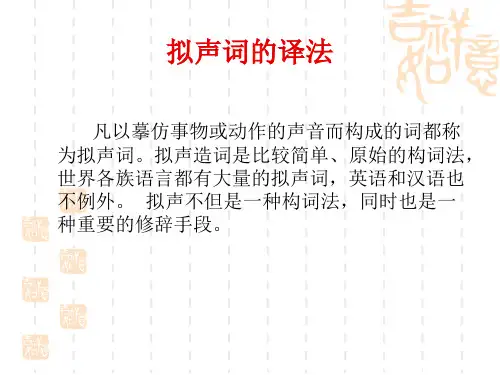
拟声词的翻译OnomatopoeiaWhat is onomatopoeia and onomatopoeic words?英语“Onomatopoeia”,源自希腊语, “onomatopoiia”,这一名称本身的意思就是“造词”(making of words”).Word formation based on the imitation of natural sounds, i.e., English words “whisper”, “bang”, “hiss”. The word may be either the name of the sound itself as “moo”, or “crash”, or the name of sound as “cuckoo” or “peewit” .(建立在拟声之上的构词法,如“whisper”, “bang”, “hiss”,拟声词是可以摹拟事物本身,如moo, crash,或者是发声物本身,如“cuckoo”, “peewit”.(红嘴鸥))拟声Onomatopoeia是利用词的发音模仿人、动物或其它物体声音特征的修辞手段,可以加强语言的直观性、形象性、生动性,具有较强的表现和感染力,产生一种如闻其声,如见其人,身临其境的效果。
[h]的发音反映猛烈使劲时相伴的气喘声,heavy重,haste急,hurry 赶紧,hiss嘘,hit 打/击,hurl猛掷。
[w]或[wh]可以表示剧烈的含义,wail哀号,wallow痛打,wrangle剧烈争吵,wham重击,whicker嘶鸣,whimper啜泣,whip鞭抽,whirl旋风,whistle哨子的尖声,whoop喘息。
[s]经常用来描述风声飒飒、树叶沙沙、蛇行咝咝,如hiss咝咝声,sizzle哧哧作响,rustle沙沙声,spatter雨滴声。
重复鼻音[m]可以象征昆虫的营营声,鸟的喃喃声,车轮的隆隆声,如humming哼哼/嗡嗡,hummer蜂鸟,murmur喃喃自语,mumble咕哝。